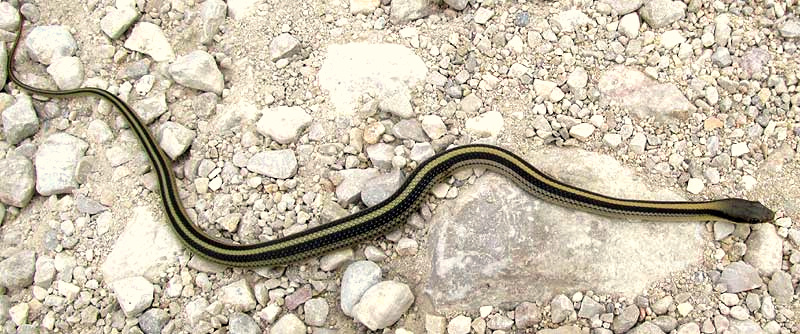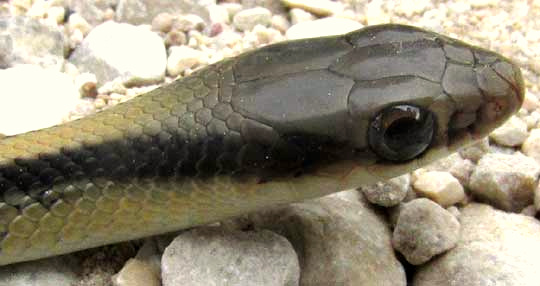Excerpts from Jim Conrad's
Naturalist Newsletter

from the October 5, 2014 Newsletter issued from the Frio Canyon Nature Education Center in the valley of the Dry Frio River in northern Uvalde County, southwestern Texas, on the southern border of the Edwards Plateau; elevation ~1750m (~5750 ft); N29.62°, W99.86°; USA
TEXAS PATCH-NOSED SNAKE
Biking down the community's little gravel road a snake only about eight inches long (21cm) turned up right in the road's middle, motionless except for his flicking tongue. That's him above.
I was tickled to see this snake, especially because during all of this extremely dry summer I've not encountered a single one. This looked like a garter or ribbon snake, so probably it wasn't anything special, but still I wanted to get some close-ups of the head, since the configuration of scales on the head are among the most important field marks in snake identification. My first head-shot is shown below:

That picture shows scale patterns on the head's top but not the important ones lining the upper and lower lips. Well, I've handled rattlesnakes and coral snakes so to get a better head picture I simply reached out to grab the little fellow right behind his head... but he was so fast -- or I was so slow -- that I got the body's middle instead. This clumsy capture enabled the critter to turn around and with teeth no more dangerous than spines on a bug's leg, he bit me! And even though the bite was completely painlessness, my innate "startle response" kicked in and before I'd even realized what had happened I'd slung that poor creature across the road, where he promptly zipped into a hole. No further head pictures.
Still, with the scales atop the head visible in the picture I already had, I figured I could at least confirm that it was an immature garter or ribbon snake. Back home with the head image on the computer screen I began comparing the scales with those atop the heads of garter and ribbon snakes featured on the Internet. Beginning with the big scales behind and above the eyes, every scale fit perfectly, and so did the smaller ones in the "nose-bridge" area. But then that last scale, the one bending down over the very front of the head -- the "rostral" scale -- turned out all wrong. Rostral scales on the heads of garter and ribbon snakes adjoin the scales behind them along a straight line. The top of our snake's down-curving rostral scale wedges like a sharp tooth between the two scales above it -- between the "internasal" scales. In snake identification, such a big difference in scale configuration is not to be ignored.
So, our snake's rostral scale sent me looking for other lined snakes found in our area, and there was one, a kind of snake I'd never heard of, a Patch-nose Snake, SALVADORA LINEATA*. The top of its tip-of-nose rostral scale is shaped just like ours. It curves down the front of the head forming a flattish "patch nose," making the snake's head look oddly blunt.
The HerpsofTexas.Org web page for the Patch-nose Snake says that it typically forages during the early morning hours for lizards and small mammals, though the species can be found hiding under boards, flat stones, and dead vegetation. In Texas the species occurs in our juniper-wooded Hill Country, the Chihuahuan Desert of Big Bend and the Trans-Pecos, then east through southern New Mexico and Arizona, and south into arid northeastern Mexico.
Apparently Patch-nose Snakes are fairly common. I've seen them here before but I thought they were Western Ribbonsnakes -- until I got a good view of that nose-tip rostral scale.